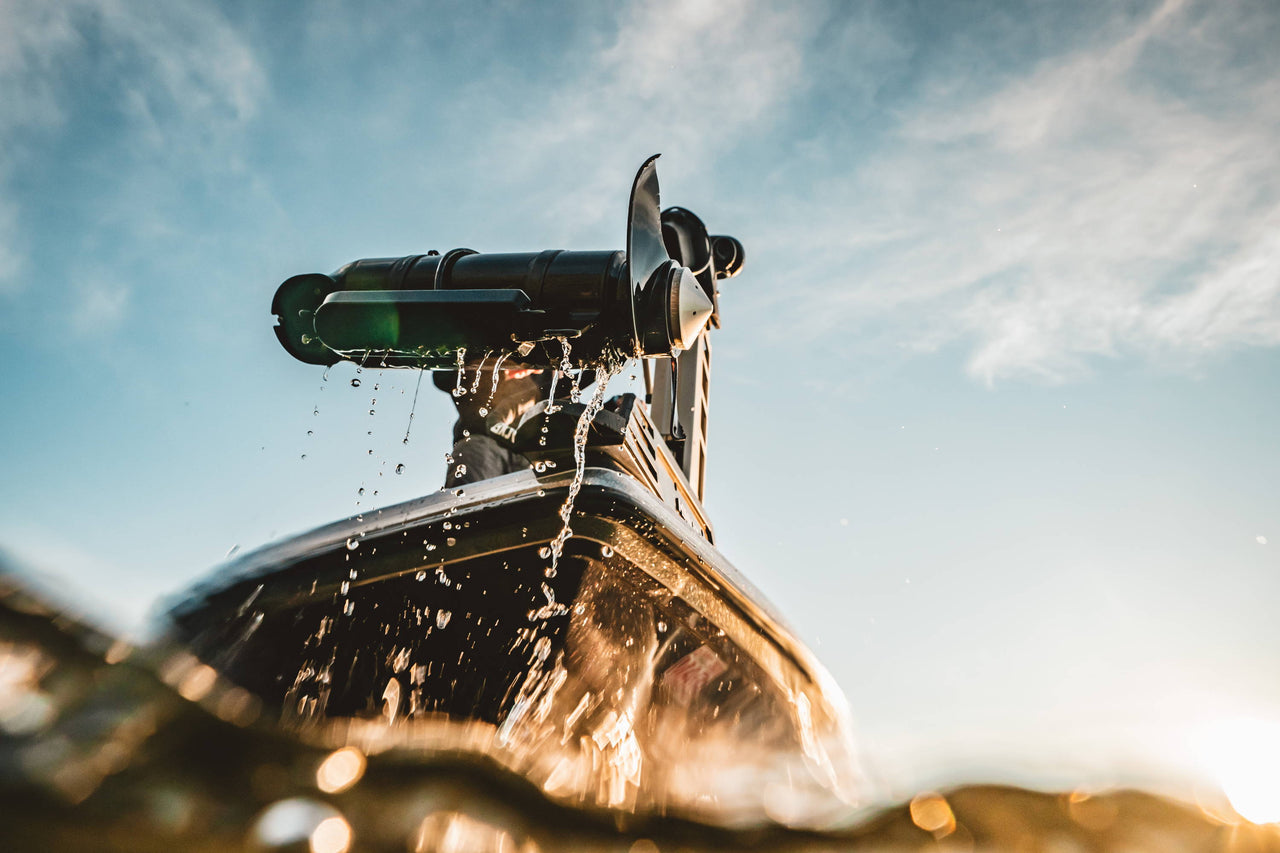When it comes to running a trolling motor on any number of boats (including Kayaks, Tiny Boats, Bass Boats, Deep Vs, Saltwater Skiffs, Bay Boats, and more), the manufacturer, model, and rigging may vary but the fundamentals remain the same. You could have a brand new, top of the line trolling motor or a weathered workhorse that does just fine for you — either way, the fact remains that you’ll get much more out of your fishing experience if you’ve taken steps toward maintaining and improving trolling motor performance.

5 Fundamental Factors for Maintaining and Improving Trolling Motor Performance
5 Factors for Maintaining and Improving Trolling Motor Performance
From increasing the power and longevity of your trolling motor to making upgrades that help you spook fewer fish, you might be surprised at the satisfaction a little tuning can bring. Even better, these types of upgrades are usually inexpensive and easy to do yourself, too.
1. Improving Trolling Motor Rigging
Mounting: It can sometimes be a challenge to mount a clamp-on trolling motor just right, so it’s important to consider trolling motor mounts that help you get it just right. We’ve seen some decent DIY ones, too, but you can get a good one for under $70 and save time and effort, too.
Fastening: When securing your trolling motor to your boat, you want a dependable hold, but it can be a real pain getting access to where you need the hardware. That’s where Toggle Bolts are the real MVP. They anchor your trolling motor into place for proper installation, and with 600 lbs of holding power and vigorous testing against the elements, they excel at keeping it there.
Wiring: You might need a circuit breaker to protect your trolling motor, wiring, and boat; you might need trolling motor plugs, receptors, or connectors to get it all hooked up; or you might need an easier way to rig wires that run alongside your trolling motor cable assembly. In any of those cases, make sure these parts are from a dependable source that provides quality parts. Usually, plugs, receptors, and connectors are needed because of a new installation or some unforseen damage. Circuit breakers, on the other hand, may be part of an installation or an upgraded wiring project design to protect your trolling motor. The concept of these circuit breakers is similar to those you'll find elsewhere: when too much power comes toward your trolling motor (anything over 50 amps), the circuit breaker reduces the risk of that power reaching your trolling motor and causing damage.
Removing / Changing Propellers: Doing propeller maintenance or changing a propeller on the fly can be incredibly quick and easy, but only if you have the right parts. When considering a propeller change, look for signs of significant wear on the blades. Nicks can often be smoothed down and tangles of weeds or line can be removed, but cracks or notches are bad news (these cause your trolling motor to be inefficient or inoperable). You might also want to change your stock propeller out for a better one or because of different conditions on a particular body of water. In any case, consider a propeller nut that requires no tools to install and remove so you can get back to fishing in no time.
Maintaining Hardware Mounts: Every couple months and before and after the season, check the mounting hardware and tighten it.
2. Enhancing Trolling Motor Power, Efficiency, and Control
Reducing Obstructions: If your trolling motor prop is covered in plants or fishing line, it isn’t going to work as efficiently or effectively. But if your prop has an enhanced cutting blade, you can help reduce the tangles that keep it from working right.
Improving Steering Control: There are plenty of great trolling motors that have two-piece shafts, but they often need some help so the shafts work together in an optimal way. That’s where Troll Perfect is a real game-changer. Troll Perfect helps you gain better control, keep a steady course, and prevent fighting with a trolling motor that needs a tighter connection where the shafts connect.
Increasing Efficiency: Your trolling motor will work better when the prop is stabilized and secured with a larger contact point. It will also work better when the prop nut has a built-in heat sink and cooling ports. This will reduce the operating temperature, improve battery life, and improve the life of your trolling motor, too. Luckily this prop nut does that and much more.
Inspecting the Drive Pin / Shear Pin: This should not be bent and should not be showing significant wear as it will likely break soon and leave you with a challenging replacement to do while fishing. Thankfully though, with the right foresight and tools, pins can be easy and inexpensive to replace.
3. Preventing Trolling Motor Damage and Damage to Your Boat
Mitigating Rough Travel: Between bumps in the road and rough water, your trolling motor and boat can take quite a beating. An ounce of prevention is worth a pound of cure though, so consider buffering those bounces or locking that trolling motor down so less harm can happen to your trolling motor, boat, and wallet.
Protecting Wires: Inclimate weather, hooks, and emergency re-rigging all pose a threat to the wires you have bundled with your trolling motor cable assembly, but there’s a patented solution that insulates, shields, and easily secures into place.
Abating Electrical Overload: When it comes to protecting something as pricey as a trolling motor (or your boat and your time, for that matter), trolling motor circuit breakers are worth more than their weight in gold.
Backing Up a Battery: Inconvenience is usually the biggest loss when a battery runs out of juice, but there can be several risks to your person and property, too. In any case, it pays to have a good battery backup system in place. This may not directly relate to your trolling motor and its battery, but if you have a battery backup on your boat, you'll no longer have to hobble back somewhere by using your trolling motor, saving your trolling motor batteries, and allowing you to just use your trolling motor for what it's intended.
Preventing Collisions: Low visibility hours don’t have to be harmful to the front of your boat. Consider a headlight that easily mounts to your trolling motor or a nearby location on your bow.
Cleaning a Trolling Motor: Typically, this can largely be accomplished with a rinse and it definitely should be done regularly when you are fishing saltwater. It's often helpful to wipe it down with a mild soap and water as well. Always consult your manufacturer for the best instructions, but it you may also want to wipe down the shaft of the trolling motor and lubricate it with a water-based silicone solution.
4. Running Your Trolling Motor with Less Strain and Effort
Upgrading a Cable and Handle: Many factory cables and handles just don’t have durability and comfort in mind. By upgrading your cable and handle, you can save some effort and make sure your cable lasts longer, too.
Lifting Easier: Especially when paired with a G-Force Handle, air pistons can make a world of difference in the amount of strain it takes to lift your trolling motor. And, for an easier and more reliable install, get some that are made to withstand the elements, come with all the necessary hardware, and look nice, too.
Slashing Time Spent Removing Weeds: Less time removing weeds means more time casting. With a blade like the Grass Goat trolling motor weed guard, you can accomplish just that.
Cooling Pedals and Boosting Traction: Barefoot anglers know just how hot a trolling motor pedal can get in the summer, but Chill Trax EVA foam pedals are a quick and simple solution. They also add traction so you have more control on the pedal during wet weather.
Rotating Pedal Placement: Want to easily mount your trolling motor pedal and freely rotate it to a convenient spot around your pedestal seat? Try the Pedal Paddle.
Boosting Pedal Visibility: It’s never been easier to use your trolling motor while night fishing — just add these right-sized lights for your recessed foot pedal.
Powering More Conveniently: You don’t always have to reach for your trolling motor handle to turn it on and you don’t have to buy a new one just to get this feature. Instead, you can conveniently power switch your trolling motor on and off with a trolling motor foot switch.
Checking Battery Connections: To prevent any situations where your trolling motor isn't drawing power like it should, regularly check your battery connections and the charge on your trolling motor battery.
5. Quieting Your Trolling Motor
Dampening Vibration and Noise: There are several ways to dampen vibration and excess noise from your trolling motor and each method comes with other benefits as well. It may not make or break your fishing every time, but it never hurts to have less mechanical noise, particularly when approaching fish under increased pressure.
Genuine Boating Essentials and G-Force Performance Parts
If you’d like to spend more time fishing and want to improve your experience on the water, check out our one stop shop for trolling motor accessories. Unlike some online stores out there knocking off T-H Marine patented products, these are genuine T-H Marine parts backed up by our standards and our commitment to our customers. That means more quality products, easier installation, and help from our team if you need it, too!






